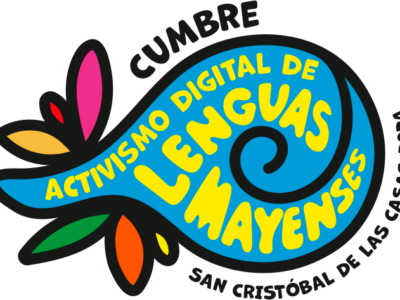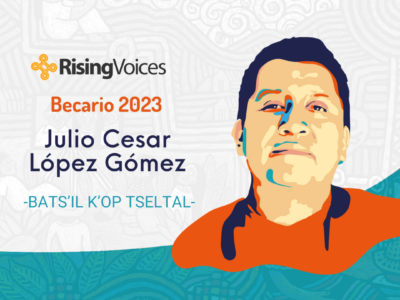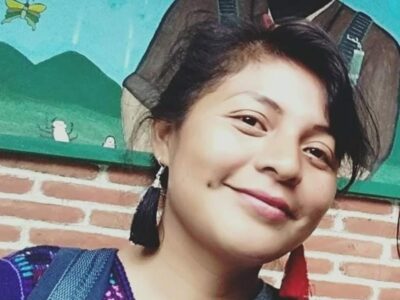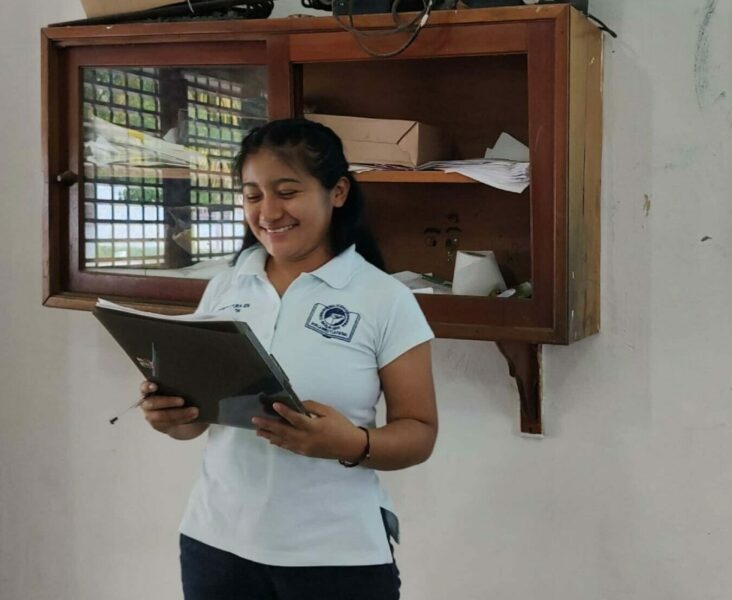
Esther Abisag Aguilar Tziu. Photo by Deysi de los Angeles Dzib Euán, used with permission.
Learn about the stories of the new generation of Fellows who are changing the digital world of Mayan languages and about their participation in the Rising Voices’ Program for Digital Activism for Mayan Languages.
Hello, thank you for reading and wanting to know more about my story. I am a young Mayan Indigenous woman from the Yucatan Peninsula, Mexico. I am not very different from other young people my age as I like watching movies, listening to music, I love reading webtoons and sometimes I like reading literature books. I like to learn to do crafts, I don't like to cook very much, but I do like to try delicious foods.
My community
I was born in the city of Cancún, the place where my parents met, and despite being from different cultures, they decided to start a family. Some time later, my father went to work in the United States, so I grew up with my maternal family in the La Esperanza community where I live now and where I learned the Mayan language with my grandparents and my aunts.
I grew up threshing corn with my grandfather, who from time to time called my attention because I sometimes got lost in my own world while playing with the cobs. When I wasn't playing, I would sit next to my grandmother while watching my mother weave hammocks or watching my aunt embroider huipiles with counted thread. I remember that when my grandfather returned from the milpa he would tell me stories in the Maya language. On rainy afternoons, I would eat freshly picked watermelon or I would peel oranges with him. Some time has passed since all this, now my grandparents are resting and are not on this earth, but they are still alive in my memories and my heart.
I am Abisag
I am a 20-year-old girl studying at the Normal School to become a primary education teacher.
To introduce myself, my name is Esther Abisag Aguilar Tziu, but I prefer to be called Abi or Abisag. I live in the community of La Esperanza, municipality of José María Morelos, in the beautiful state of Quintana Roo in Mexico. The community has the jungle and the sea with a rich history of young people. In our region, we enjoy abundant natural and cultural wealth. From seas, lagoons, and cenotes, to the deep river, in addition to the beautiful and dense jungle, the trees and the animals that live in the mountains, it is not for nothing that they say that the Mayab (the original name of the Yucatán Peninsula in the Maya language) is the land of the pheasant and the deer.
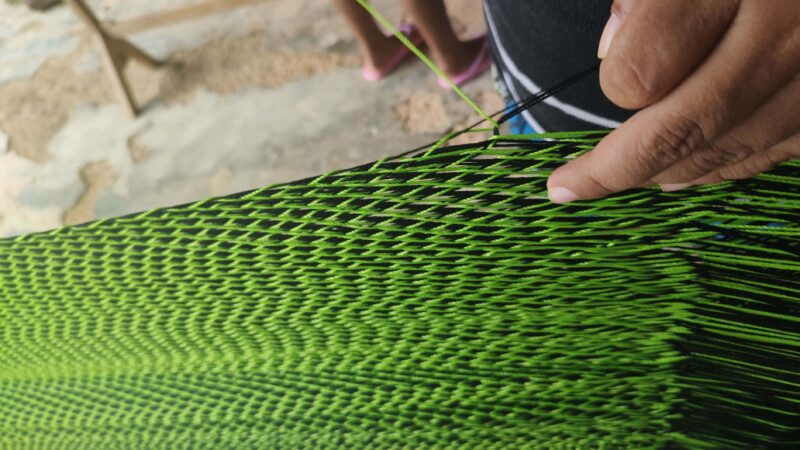
Hammock workshop: The process of making a hammock in the form of a honeycomb. Photo by Abisag Aguilar, used with permission.
I really like my community, even though I sometimes complain that ice cream isn't sold here. I am glad that my neighbors make natural and seasonal fruit flavors to sell (they are very tasty). The shops open very early to sell cookies and biscuits with coffee for breakfast, and at that time the men also go to their cornfields taking their sabucán (backpacks) and their pozol for a midday meal. In the afternoons, the mothers weave their hammocks, cook, go to their fields or go to work peeling wood with their coa tools.
In my town there are many things to do, for example: raising chickens, going out to play in the park, watching baseball in the field, going to the cornfield, peeling wood, making chewing gum, harvesting honey, shelling corn, going shopping, or going to find a car to go to Morelos, the municipal seat.
When we go out to Morelos, there are many curves on the road and they make you dizzy, but even though I complain about the trip, I like to go because I listen to the conversations of my neighbors. With jokes and laughter we arrive in Morelos and in the same way we return, so I end up very dizzy but also well informed. Sometimes thanks to the conversations in the car, I find out that it will rain or that it will be hotter depending on how the more knowledgeable neighbors see the sun.
During these conversations in Mayan, we learn more about the world and life. For me, my Mayan language is very valuable because thanks to it I have access to a world of wisdom and knowledge, because speaking in my language includes me in more conversations and it brings me closer to my community.

Sunset in the community of La Esperanza. Photo by Abisag Aguilar, used with permission
‘KI´KI´KUXTAL’ (The Good Life)
In La Esperanza there are fewer and fewer young people and children who speak our language. Although we understand it and know how to speak it, sometimes because we're not in the habit, we prefer not to, so when adults see our behavior they also prefer to speak to us in Spanish. It's not that it's bad, but it is beautiful when we communicate in Maya with others. For this reason, whenever I have the opportunity, I speak my language and in this way we communicate better, the conversation is more complex and I learn a couple of new things.
It is for all of the above reasons that I decided to carry out the project “KI'KI'KUXTAL” (The Good Life). The project's objective will be to share through social networks (such as Facebook, YouTube and TikTok) videos of traditional food recipes, preparation of medicines, and of traditional sweets from the region, all narrated in our Mayan language and translated into Spanish. These videos will be screened at small community events in the central square with a domed roof so that the community, children and youth can see them first and then the videos can be shared on social networks.
My main interest in this project is the revitalization of the Maya language in the community and encourage its use on social networks. In addition, I am interested in documenting some knowledge that has been lost, such as recipes and natural remedies, because I am interested in getting young people closer to this knowledge and these practices, in addition to learning from each other.
I think that technology and social networks are tools that should be used as much as possible, within and with our communities. For me, digital activism represents a basis for the recognition of my language, because, thanks to the reach of the internet, videos and other types of publications can be disseminated to many people and thus contribute to the revitalization of Indigenous languages, in this case, the Maya language.
The Mayan people are still alive
Currently, the virtual world is one of the main forms of entertainment and communication, so we can take advantage of its reach to publicize our culture and show the world that the Mayas are still here, that some things have changed but our essence has remained. I have seen for a long time the misconception that the Maya became extinct or disappeared and I must admit that at some point I believed it too, but now I know that we are still alive. Maybe we no longer wear the same clothes as before or we changed some things in our life, but we continue to have the same vision of the world, we eat what Mother Earth gives us and we work in the same way. There are things that we cannot lose like our language and we must continue to hold on to it.

Yucatán Fellows of the Digital Activism Program of Mayan Languages. Photo by Lorenzo Itzá, used with permission.
Seeing that our identity is being lost little by little with each generation, that we are changing our uses and customs more and more, forgetting many of the things that identify us as Mayas, made me start creating this project. Now, as part of the Mayan Languages Digital Activism Program, I can develop it and start working with my community, which makes me very excited, and at the same time makes me very nervous, but I am very happy to have this opportunity, so I want to take advantage of it at maximum.
There may be some challenges in the development of the project, for example it could rain on the days of the events and the video will not be able to be projected on the central square's dome, or the electrical power goes out and it is not possible to carry out the event. Sometimes I get a little worried that my people won't want to participate in the videos or that no one will go to the events, but I've been asking and inviting my neighbors and friends from the community and they have assured me that they would be very happy to come.
I would like the Mayan language to be used again in my community as before, and that with these projects children and young people appreciate their culture and learn from the advice of the elders about life and their community. I would like more communities to join in revitalizing their language and traditions, and for this project to be like the fluttering of a butterfly, which can create an impact also in other parts of the world.
Follow my project https://youtube.com/@KikiKuxtal / TikTok: @kiki.kuxtal
@actlenguas Ella es Abisag @kiki.kuxtal, hablante de la lengua maya y este año 2023 forma parte del Programa #ADLM#ActivismoDigital MaayatꞋaan

